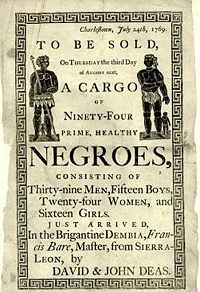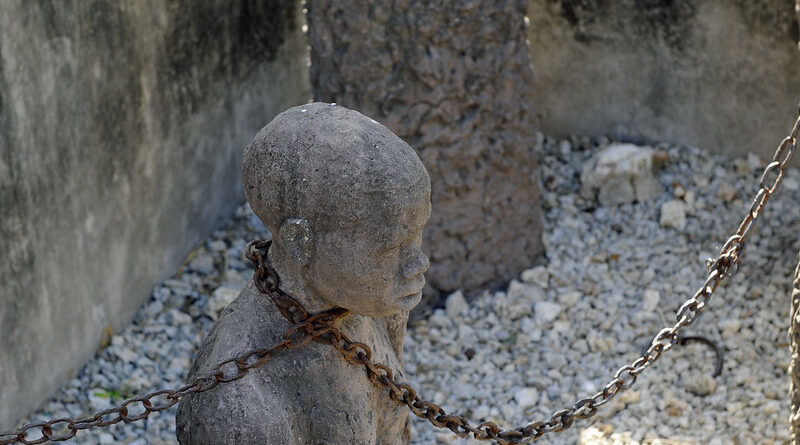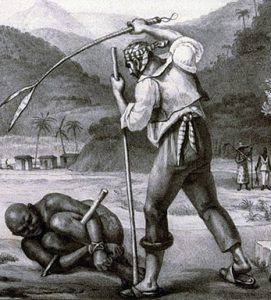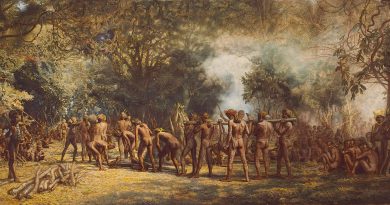The Transatlantic Slave Trade
The Transatlantic Slave Trade (1501-1867), sold at least 12.5 million black Africans as slaves to work for white land-owners on the other side of the ocean. Of these 1.8 million died at sea. Most of the rest were worked to death within seven years in the sugar cane fields of Brazil and the Caribbean.
The Beginning Of The Slave Trade
The slave trade began in the 15th century shortly after Genoese Antonio de Noli and the Portuguese Diogo Gomes discovered the once uninhabited Cape Verde Islands. These islands included: Santiago, Fogo, Boavista and Sal. Additionally, another Portuguese sailor, Diogo Afonso, discovered the Northern Islands of Sano Antao, Sao Vicente and Sao Nicolau.
Two settlements were established when it was determined that Santiago was the most desirable island, both strategically and agriculturally. In the north-eastern part was Alcatraz and in the south was the Ribeira Grande, currently known as “Cidade de Santiago de Cabo Verde.” New settlers were lured to the Cape Verde Islands by the promise of exclusive trading rights along the West African coast between Senegal and Sierra Leone.
As the new settlers began to plant and reap on the land, they realized they would not be able to handle the entire workload themselves and decided to seek out slaves along the African coast to fulfill these unpaid positions. This marked the beginning of several centuries of an inhumane slave trade.
Ribeira Grande was known as the main center of trade and also dominated the slave trade between the west coast of Africa, America and Europe for nearly two hundred years. Additionally, through a hodgepodge of budding races, cultures, plants and animals, the Creole identity was formed here.
The Middle Passage
The Middle Passage, often lasting from one to three months, was frequently called the Triangular Trade, which included a three-part journey. The second part of the journey was the worst. African men, women and children were taken by ship to the Americas, where the conditions on-board were terrible.
The problems started even before setting sail, with violence taking place once the Africans realized that they were being sent far away from home. Some took drastic measures and jumped overboard, either drowning or being consumed by waiting sharks.
According to ship regulations, only 350 people were to be transported at a time, although mainly in the 18th Century, these regulations were defied, by what was termed “tight packers” where some ships carried more than 800 people.
Life On Board The Ship
Daily life on board the ship was awful. The slaves were stripped naked and branded. Conditions on board were filthy, cramped and they were often forced to lie in spaces smaller than a grave with agonizing heat. The slaves were also piled on top of each other in what is called, spoon fashion.
Men were shackled under deck where there was no shortage of malnutrition or diseases, including dysentery and smallpox and the bodies of slaves were frequently covered in lice too. In some cases women and children were given permission to wander around the deck.
Meals
The first meal of the day would be served at 9am. Depending on where you came from – your meals would be different. For instance, Africans from the Northern part of the Guinea Coast were served boiled rice, millet or cornmeal. Those from the West African coast were fed stewed yams and if you hailed from the Congo basin you would have been served cassava flour and fruits such as bananas.
Occasionally the slaves would be allowed to have a small serving of raw meat to make sure they remained strong and healthy. Water was strictly rationed. No more than half-pint of water was given to each person, dished out in a small pan, called a pannikin.
The slaves were fed an afternoon meal, also known as the second and last meal of the day. They were served the cheapest form of accessible food, which at the time was boiled broad beans covered with a mixture of palm oil, flour and water. The taste of these beans left much to be desired and a substantial amount of red pepper, called “slabber sauce,” was used to mask the unpleasant taste.
Physical Activity
In order for the slaves to be sold at higher prices, they needed to be in peak physical shape. The slaves, sadly still shackled together, were “danced” on deck to get their exercise in for the day. Those who refused were whipped with the painful and barbaric cat-o’-nine-tails whip. It was made up of nine tar covered cords, with a knot at the end of each. This whip was brutal, able to slash a slave’s skin in only a few thrashes.
Additionally, a crew member would either play the African banjo or a fiddle. The men were made to jump up and down until often times, their ankles would be raw and bleeding due to the iron chains around them. In contrast, the women and children were not shackled. This allowed them to dance to the rhythm of the music being played. This was their one small chunk of recreation during the day. It was viewed as an escape, even just for these fleeting moments where they were not lying in the filth and sadness that consumed the majority of their day on the ship.
Bad Weather
Bad weather was considered the worst time of the Middle Passage aboard the ship. When storms occurred, the slaves were obligated to remain below deck all day and night. The holds were dark, grimy and greasy and reeked of death. On the other hand, the “tween decks,” filled with both the living and the dead, also contained great amounts of blood, vomit, urine and waste.
One basic human need, food, was interrupted when bad weather struck. Instead of being fed their usual meals, they were left no choice but to chew on the small crumbs and pieces of spoiled food that they could find.
Sexual Abuse
Sexual abuse was known as “bed warming.” During the night, either a crew member or even the captain would take a slave woman from the ‘tween decks” to the captain’s chamber or the crew member’s living quarters. The women were not only beaten but in most cases sexually abused.
Slave Rebellion On Board
Some slaves attempted to escape the torturous conditions by starving themselves, but the crew would not allow this. They would whip the slaves, torment them with hot coals on their skin and even forced their mouths open, using special instruments to break their teeth.
One of these instruments was called the “speculum oris”, made of wood, and resembled a pair of dividers. This would be forced into their mouths to pry open the jaws. Once opened, food was jammed down their mouths, causing gagging and vomiting. Captains would also pour melted lava on slaves who refused to eat.
Some slaves made basic weapons from their chains and shackles and then tried to kill crew members while they were on deck. The crew, however, would quickly put down these uprisings with their advanced weapons of pistols and rifles. There were a very limited amount of successful slave rebellions, apart from one of the most notable aboard the Amistad in 1839 when a 25-year-old slave named Sengbe Pieh (or “Cinque” to his Spanish captors) broke out of his shackles and released the other Africans. The slaves then revolted, killing most of the crew of the Amistad, including her cook and captain..
The slaves were in such misery that they resorted to other forms of rebellion such as committing suicide. Countless numbers threw themselves overboard, while others cut their throats to be free of the unbearable conditions.
Arrival In North America
Many slaves didn’t live to see the North American shores. They died during the voyage from overcrowding, diseases such as the outbreak of smallpox and ophthalmia, a blinding disease. These awful outbreaks could rapidly spread through an entire ship in days. Sadly, some slaves become insane and once they were found out, their lives were in jeopardy. Often times, they were brought up on deck where they were either whipped and beaten to death and then disposed of overboard.
Leading up to the days before the ship’s arrival in North America, the slaves that had survived were fed better to appear more appealing to the slave buyers when it came time to sell them, however the abuse was still not over.
Their skin was oiled to create shine and hot tar was used to hide the abuse that left marks of scarred evidence on their bodi es. It was assumed that if the slaves appeared to have no imperfections on their bodies, their market price would increase. Baptizing the slaves was also another way to increase their market value.
es. It was assumed that if the slaves appeared to have no imperfections on their bodies, their market price would increase. Baptizing the slaves was also another way to increase their market value.
Out of an estimated ten million men and women who survived the Middle Passage, roughly 5 percent or 450,000 Africans landed on North America’s shores. Brazil and the Caribbean received approximately nine times as many Africans.
Enslaved Africans In The United States
In the development of the states of South Carolina, Georgia, Virginia and Maryland, it was crucial to them to use slaves to to perform the hard labor required on the land.
Most slaves worked on plantations and farms for work in cash crop agriculture, growing: rice, cotton, indigo as well as other crops. They also worked on tobacco farms in Virginia and Maryland and others were used in mining and servicing the commercial economy and some put to work as domestic servants.
Caribbean Plantations
The Jarrett Family Plantation
Built in 1794, The Jarrett Family plantation is known as the oldest sugar plantation in Jamaica owned by the Kerr-Jarret family of the Barnett Estates. Nicholas Jarrett made a fortune from the sugar harvested on his plantation. These two families were united when Major General David Kerr arrived in Jamaica in the 1700s and took a position at this estate as a medical doctor. He eventually ended up marrying Sarah Newton Jarrett, daughter of Nicholas Jarrett. These two families formed a dominant alliance of family pride and national pride, which ended up playing a central role in the growth of Jamaica.
Bayleys Plantation, Barbados
Joseph Bailey formed this plantation between 1719 and 1738. In 1812 it spread over 444 acres and on April 14, 1863, this plantation was home to the biggest slave uprising against white plantation owners. This was led by a handful of African slaves, the most prominent was Bussa and the rebellion is now known as Bussa’s Rebellion. Very little is known about him, except that he was a ranger at the Bayley plantation in St. Philip. A ranger was the head officer among the enslaved workers on an estate. This rebellion was carefully planned and organized by the senior enslaved men and women who worked on several estates and plantations. The uprising started at Bayley’s estate. It was an attempt by the enslaved people to change the society on Barbados. They believed that Barbados belonged to them and wanted their freedom from the plantation owners. Today, Bayleys Plantation is the home and recording studio to musician Eddy Grant.
Morgan Lewis Mill
This was the last sugar windmill to operate in Barbados. Sugar was the largest commercial export that replaced tobacco in the late 1700’s. This sugar based economy was sustained by slavery. Other plantation houses in this area were Sunbury plantation house, Francia house, Drax Hall and Codrington College. Bussa is also commemorated here with a statue
of himself, 169 years after his rebellion, symbolizing the efforts of his fellow slaves to revolt against slavery and to fight for emancipation.
Betty’s Hope Sugar Plantation
Betty’s Hope was established in 1650 in Antigua and was the first large- scale sugar plantation to function in Antigua. It was controlled by a small amount of European managers and was an agricultural and industrial venture. However, it is also where over hundreds of African slaves lived out their lives as the labor force behind this plantation, which brought accolades to the estate. Even after emancipation in 1834, they continued to work on this estate as freed labor.
Slave Conditions On Plantations
When plantation owners purchased their new slaves, they would change their names, often giving them English, Biblical, Roman or names of famous people. In order to identify their slaves, they would brand them with estate marks. Slaves had no rights, from not receiving pay to not being allowed to leave the plantation without their master’s permission. They were also forbidden to learn basic reading and writing.
When punishing the slaves, no mercy was given to them. Besides diseases such as dysentery and pneumonia being rampant on the plantations, slaves were harshly punished by cutting their ears and hands off for the most minor offence. In the most extreme conditions, they were buried alive or hanged.
Additionally, the slaves barely had any personal time, working 18 to 24 hours for five or six months at a time because the sugar cane process could not be disturbed.
Slaves were split into three groups based on how healthy and strong they were.
Group one were the healthiest and fittest slaves. Their duties included preparing the soil, digging cane holes, planting and fertilizing the canes as well as burning and cutting the sugarcane at harvest time.
Group two contained weaker slaves, who would weed crops, carry manure to the cane fields and supply crushed cane stalks into the furnaces at the sugar factory.
Group three consisted of the young ones, mostly children and their job was to keep an eye on the plantation’s livestock.
Although the female slaves typically worked as a domestic staff member, they were not free from punishment. They were often sexually abused by their masters.
In the Caribbean, slaves were allowed to grow their own crops. These crops would be food for the slaves and if there was a surplus, they were allowed to sell them in the local markets. Marriage was another sensitive topic. In North America, slaves needed permission from their master to marry. Even if the slaves did get married, they weren’t recognized legally.
Slave Culture
Even amidst the torturous conditions, the slaves were successful in creating a vital culture of their own. Their culture wielded a weighty influence on all aspects of American culture. Certain words in the American language contain African roots, such as bogus, bug, phony, yam, tote, gumbo, jamboree, jazz and funky.
Food has been influenced by deep-fat frying, gumbos and fricassees, stemming from West and Central Africa. Music was also a profound influence on sea shanties and yodelling, as well as spirituals and the use of falsetto. Africans also played a vital role in the production of crops, including rice and sweet potatoes that had not previously been introduced to the English or North Americans.
Folklore was a way for the slaves to create a sense of separate identity and tried to convey helpful lessons to their children. The most popular folk-tales were animal trickster stories, like the Brer Rabbit tales, which sprung from similar African stories. These stories taught lessons of powerless creatures who achieved their will through wit and cleverness, not power and authority.
In the Caribbean Islands of Antigua and Barbuda, foods such as eddo, ochre, dasheen, eggplant and bona-vista bean represented their culture. Additionally, Rastafarianism in an active religious doctrine with African roots in the Caribbean and the Antiguan Creole existing today, also has words originating from West African roots.
Slave Resistance And Rebellion
Day-to-day resistance was the most common form of opposition to slavery. The enslaved Africans would break tools, feign illness, stage slowdowns and commit acts of arson and sabotage as well as run away, usually short distances to withhold their labor as a way of bargaining with their owners.
The slaves wished for better work conditions, free time they could enjoy, monetary rewards, access to garden plots and the privileges that were automatically given to the white slave owners, such as the freedom to practice burials, marriages and religious ceremonies where approval would not be needed to proceed.
There were several slave uprisings in places such as, Long Island in 1708 and New York City in 1712. Slaves in South Carolina also staged a rebellion, known as the Stono Rebellion in 1739. They confiscated weapons, killed whites and burned houses. In the 18th century, slave revolts continued in Guadeloupe, Grenada, Jamaica, Surinam, San Domingue (Haiti), Venezuela and the Windward Island.
In the early 19th century, revolts against slavery persisted in Richmond, Virginia, Louisiana in Barbados, Charleston, South Carolina, Jamaica and in Southampton County, Virginia.
These revolts could only occur during certain times. These included when slaves outnumbered whites, in areas such as Jamaica, when masters were absent, during times of economic suffering and when there were disagreements between those who ruled the plantations. However, the south which had a much larger white population, were committed to suppressing rebellion.
Even though the slaves attempted to stand up for their freedom and rights, oftentimes they were retaliated against in the worst possible ways. For instance, after a slave rebellion in New York City in 1740, 18 slaves were hanged and 13 were burned alive.
Abolition Of Slavery
In 1787, the U.S. Constitution specified that “The Migration or Importation of such persons as any of the States now existing shall think proper to admit, shall not be prohibited by the Congress prior to the year one thousand eight hundred and eight, but a Tax or duty may be imposed on such importation, not exceeding ten dollars for each person.” Consequently, the U.S. abolished its slave trade from Africa, which went into action on January 1, 1808.
Even though slavery was abolished in the U.S., it would continue for another 52 years, until 1860. This illegal slave trade managed to prosper for numerous decades. Congress passed a harsher law in 1820, which stated that international slave trading was an act of piracy, which could be punishable by death. Only one American was executed for this crime. Slaves were still being transported between 1801 and 1867, mainly to Cuba and Brazil.
Slavery continued in the United States until its end in 1865, while Cuba and Brazil were the last two countries to finally emancipate the slaves, which came in 1886 and 1888.









